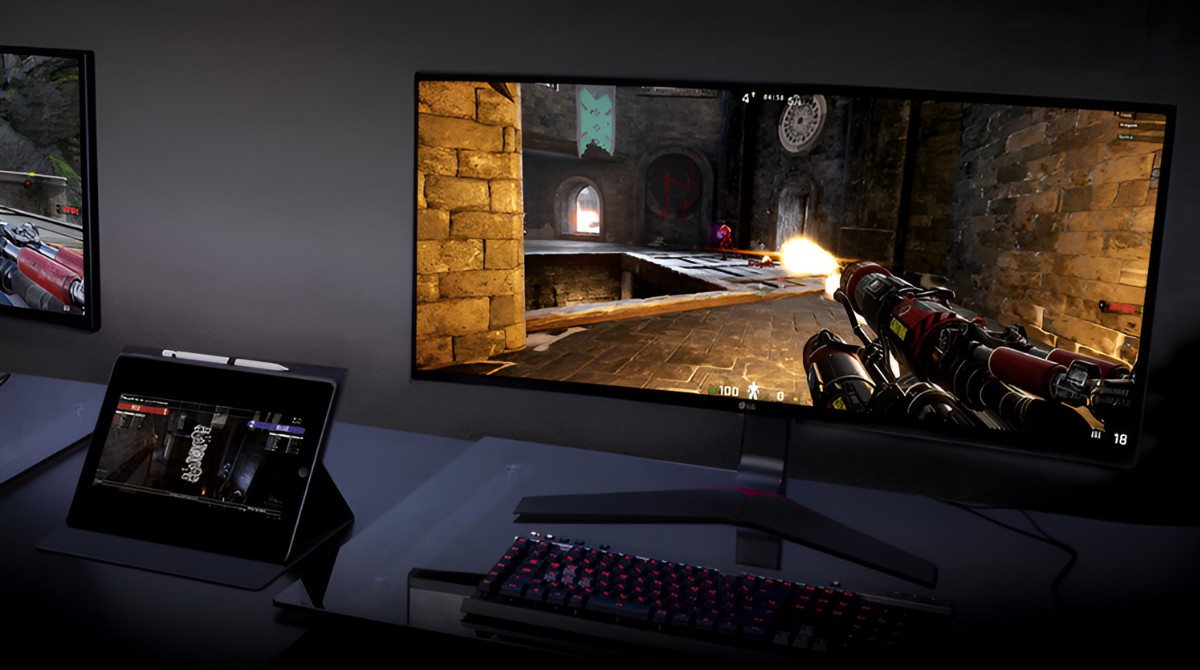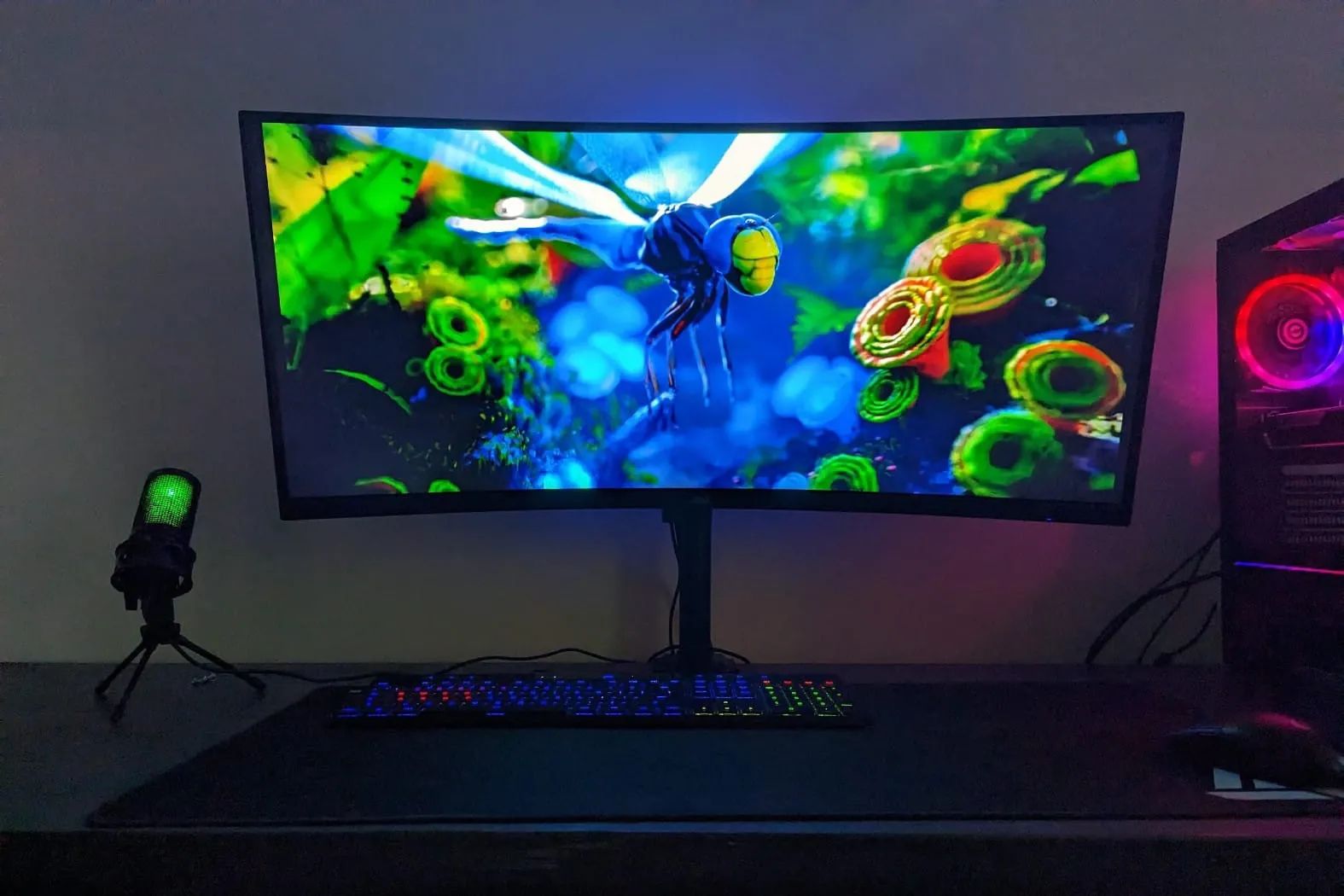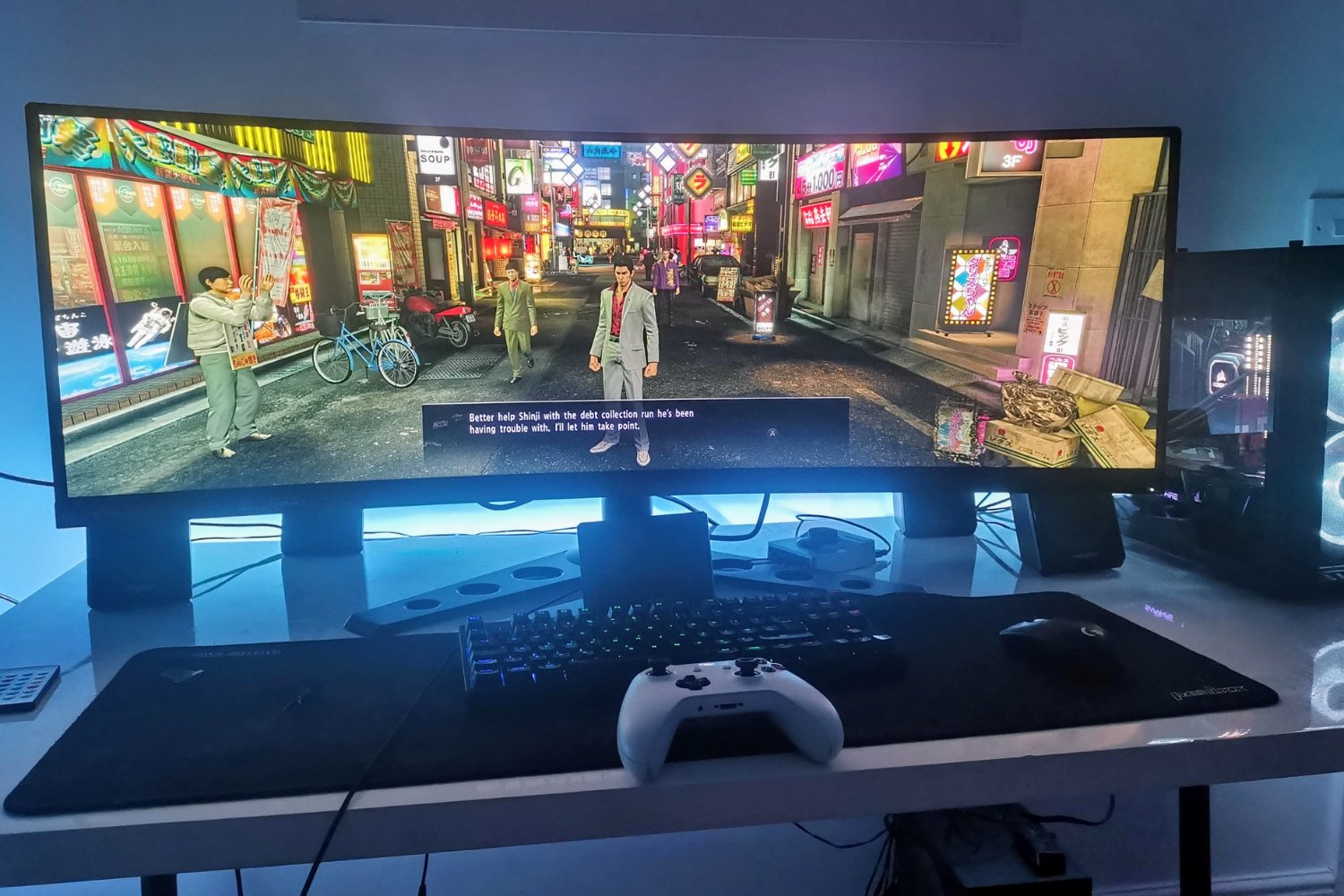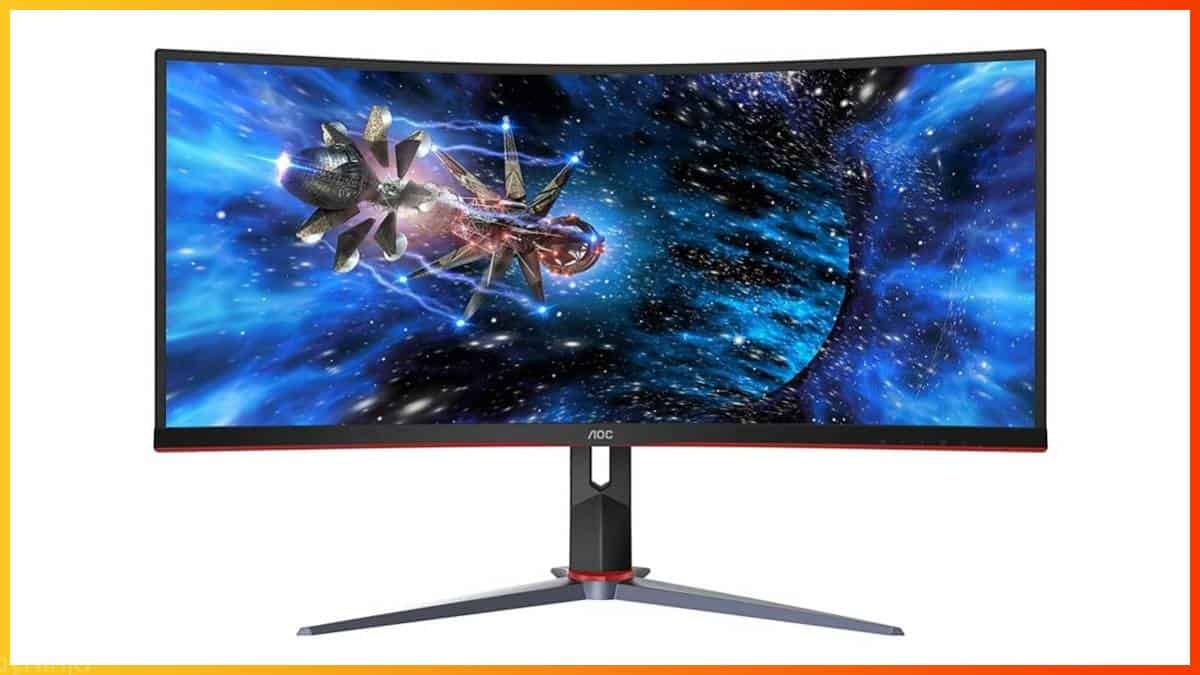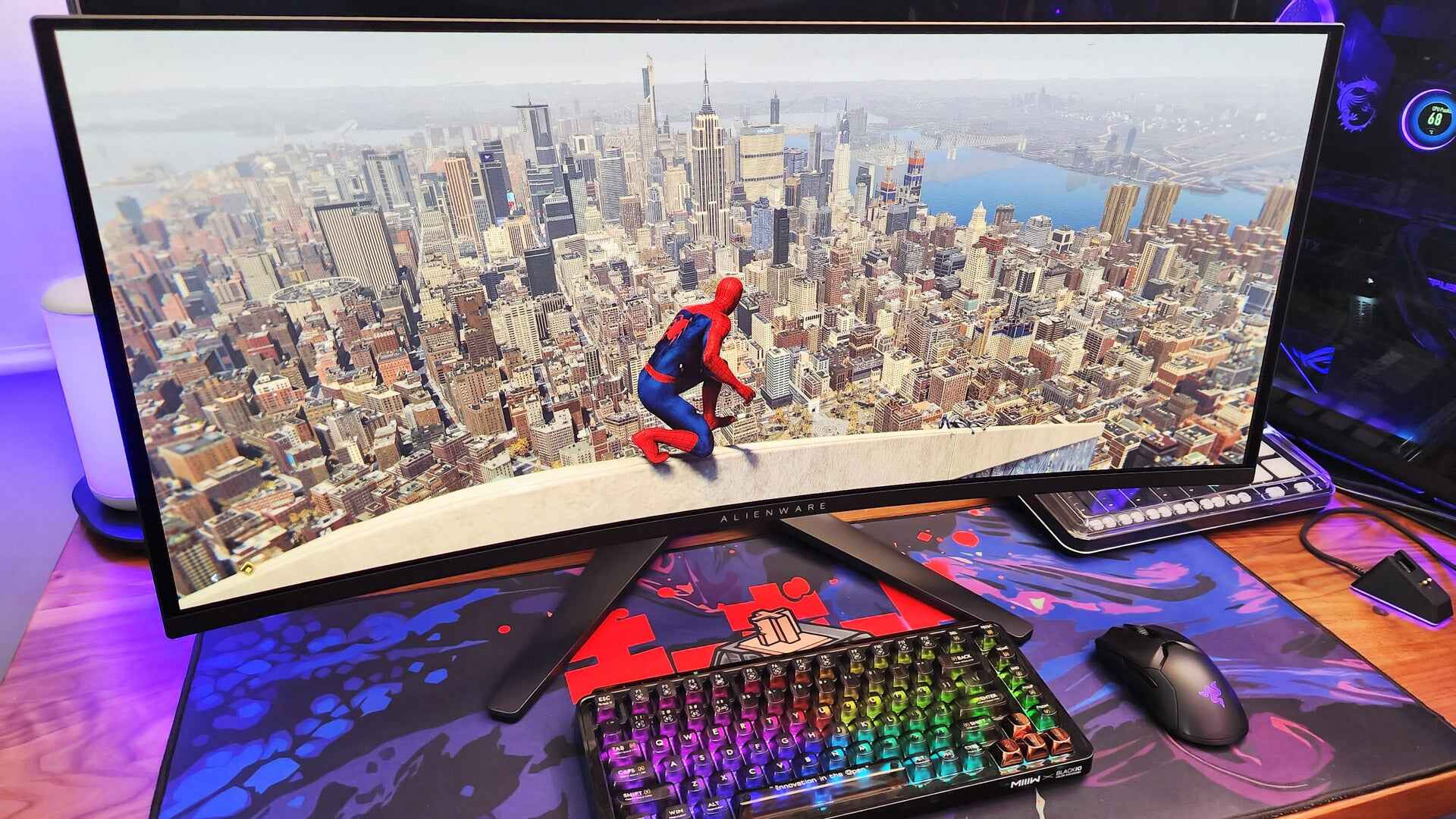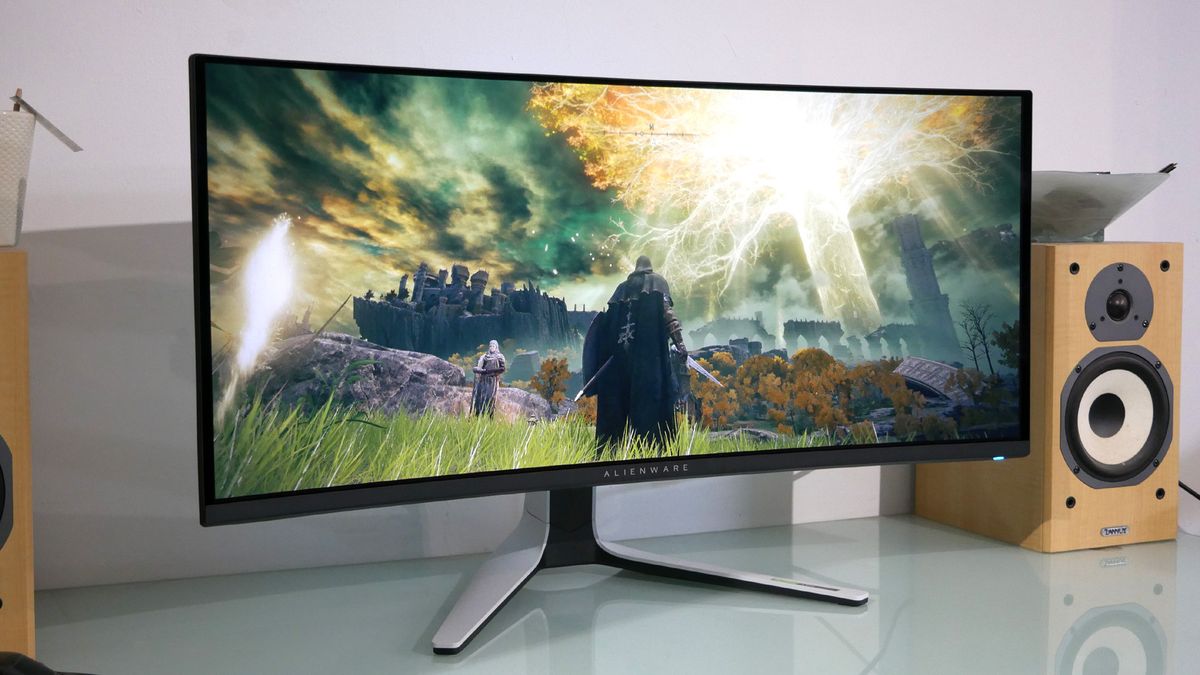Introduction
Gaming has become an increasingly immersive experience, with technology constantly pushing boundaries to enhance the player’s engagement and enjoyment. One such advancement in gaming displays is the introduction of ultrawide monitors. These monitors offer a wider aspect ratio than traditional monitors, providing gamers with a more expansive field of view and a heightened sense of immersion.
But what exactly is an ultrawide monitor? An ultrawide monitor typically has an aspect ratio of 21:9, compared to the standard 16:9 ratio of most monitors. This means that the screen is wider, allowing for a wider horizontal view and a more cinematic gaming experience. The extra screen real estate provided by an ultrawide monitor can have several benefits for gamers.
In this article, we will explore the benefits and potential drawbacks of using an ultrawide monitor for gaming. We will discuss how it can enhance immersion, provide a wider field of view, facilitate better multitasking, and potentially increase productivity. We will also touch upon the higher hardware requirements, limited game compatibility, and price considerations that come with opting for an ultrawide monitor. By the end of this article, you will have a clearer understanding of whether an ultrawide monitor can truly make a difference in your gaming experience.
What is an Ultrawide Monitor?
An ultrawide monitor is a type of display that offers a wider aspect ratio than traditional monitors. While most monitors have a standard 16:9 aspect ratio, ultrawide monitors typically have an aspect ratio of 21:9, or even wider. This means that the screen is wider and provides a more expansive viewing area.
These monitors come in various sizes, ranging from 29 inches to 49 inches or larger. They offer a significantly larger screen space, allowing gamers to see more of the game world without the need to constantly pan or scroll. This wider screen can enhance the gaming experience by providing a more immersive and panoramic view.
Ultrawide monitors are designed to mimic the wider aspect ratio of movie theaters, creating a cinematic feel for gaming. With the extra screen real estate, gamers can enjoy a more visually stunning experience, as details and environments can be displayed in a larger format.
It is important to note that ultrawide monitors are not the same as dual monitors. While dual monitors provide two separate screens, ultrawide monitors offer a single, seamless display. This eliminates the bezel between the two screens, creating a more natural and immersive gaming environment.
Furthermore, most ultrawide monitors also have a curved design. The curvature of the display helps to wrap the image around the gamer’s peripheral vision, further enhancing immersion and providing a more immersive field of view. This curved design creates a more engaging and immersive experience, drawing the gamer into the virtual world.
Overall, an ultrawide monitor offers a unique and expansive viewing experience for gaming. It provides a wider aspect ratio, larger screen space, and a curved design to create a more immersive and cinematic atmosphere. Now that we have a clear understanding of what an ultrawide monitor is, let’s delve into its benefits specifically for gaming.
Benefits of an Ultrawide Monitor for Gaming
Ultrawide monitors offer several advantages that can greatly enhance the gaming experience. These benefits extend beyond just the visual aspect and can significantly impact gameplay and overall immersion. Let’s explore some of the key benefits of using an ultrawide monitor for gaming:
1. Enhanced Immersion: The wider aspect ratio of an ultrawide monitor creates a more immersive gaming experience. With a larger field of view, gamers can see more of the game world without having to constantly turn their character or pan the camera. This broader view makes gamers feel more connected to the virtual environment, enhancing the sense of immersion and realism.
2. Wider Field of View: An ultrawide monitor provides a wider field of view, allowing gamers to see more peripheral details that may be missed on a standard monitor. This wider perspective can be particularly advantageous in first-person shooter games, racing games, and open-world exploration games. Gamers can spot enemies or obstacles from the corner of their eyes, providing a competitive edge and a more comprehensive gaming experience.
3. Better Multitasking: Ultrawide monitors offer extra screen space, which can be beneficial for multitasking while gaming. Players can have game-related resources, such as maps, walkthroughs, or chat windows, open on one side of the screen while still fully enjoying the game on the main screen. This streamlines the gaming experience by eliminating the need to constantly switch between windows, improving overall efficiency and convenience.
4. Increased Productivity: Beyond gaming, an ultrawide monitor can also enhance productivity. The extra screen space can be utilized for work-related tasks, such as video editing, coding, or content creation. Users can have multiple applications or documents open side by side, allowing for more efficient workflow and easier organization of tasks.
5. Immersive Cinematic Experience: Gaming on an ultrawide monitor offers a more immersive cinematic experience. The wider aspect ratio is similar to what is seen in movie theaters, providing a more cinematic atmosphere during gameplay. This can enhance the overall enjoyment and entertainment value of the gaming experience, making it feel more like a grand adventure.
6. Improved Graphics and Detail: With the extra screen space, games can be displayed in higher resolutions and with more detail. This means that textures, environments, and character models can be showcased in greater detail, leading to a visually stunning and immersive gaming experience. The wider screen also reduces the occurrence of screen tearing, helping to maintain a smooth and seamless gaming experience.
These are just a few of the many benefits of gaming on an ultrawide monitor. The enhanced immersion, wider field of view, improved multitasking capabilities, increased productivity, cinematic experience, and improved graphics and detail all contribute to making gaming on an ultrawide monitor a truly captivating experience.
Enhanced Immersion
One of the key benefits of gaming on an ultrawide monitor is the enhanced level of immersion it provides. The wider aspect ratio and larger field of view create a more immersive gaming experience, bringing players closer to the action and making them feel more connected to the virtual world.
With an ultrawide monitor, gamers can see more of the game world without the need for constant camera panning or character turning. The wider view allows for a more natural and seamless experience as players can take in more of the environment at once. Whether it’s exploring a vast open-world or engaging in intense battles, the wider field of view captures more of the action and enhances the sense of being part of the game.
The immersive nature of an ultrawide monitor is particularly evident when playing first-person shooter (FPS) games. In FPS games, having a wide field of view can provide a significant advantage by allowing players to spot enemies and objects in their peripheral vision. This wider perspective enhances situational awareness, enabling players to make quicker and more informed decisions during gameplay.
Furthermore, the curved design of many ultrawide monitors adds another layer of immersion. The gentle curvature of the screen helps to wrap the image around the player’s peripheral vision, creating a more encompassing and immersive experience. This curvature makes it easier for the player’s eyes to perceive the game world as a cohesive whole, further enhancing the sense of immersion and making the gaming experience more enjoyable.
Additionally, the visual appeal of an ultrawide monitor contributes to the overall immersion. The wider aspect ratio provides a more cinematic feel, similar to what is experienced in movie theaters. Games display with a broader view, making expansive landscapes and detailed environments more captivating. This extra visual real estate allows for a more breathtaking experience, bringing the virtual world to life in a way that is truly engaging.
Overall, the enhanced immersion offered by an ultrawide monitor takes gaming to a whole new level. The wider field of view, seamless and panoramic visuals, and the curved design create a more immersive and captivating experience. Whether you’re exploring fantastical realms or engaging in intense battles, the enhanced immersion provided by an ultrawide monitor can make your gaming adventures feel incredibly lifelike and immersive.
Wider Field of View
One of the standout advantages of gaming on an ultrawide monitor is the wider field of view it offers. With its wider aspect ratio compared to traditional monitors, an ultrawide monitor provides gamers with a broader view of the game world, giving them a competitive edge and a more immersive gaming experience.
The wider field of view allows gamers to see more of their surroundings without the need for constant camera adjustments. Whether it’s an open-world exploration game or a fast-paced multiplayer shooter, the wider aspect ratio of an ultrawide monitor captures a wider span of the game environment. This expanded view opens up new possibilities for strategic gameplay, as players can spot enemies, resources, and objectives that may be hidden or overlooked on a standard monitor.
In FPS games, a wider field of view can be particularly advantageous. It allows players to be more aware of their surroundings, reducing the chances of being ambushed or caught off guard. Gamers can spot opponents approaching from their peripheral vision, giving them an opportunity to react quickly and gain a competitive edge in combat situations.
Furthermore, the wider field of view can enhance the overall gameplay experience in racing games. Players can see more of the track, including curves and obstacles, enabling them to make better-informed decisions on when to turn, brake, or overtake opponents. This extra visual information can significantly improve racing performance and make the gameplay more engaging and enjoyable.
In open-world games, the wider field of view allows players to take in the expansive landscapes and immerse themselves fully in the virtual world. Whether it’s admiring the breathtaking scenery or exploring hidden nooks and crannies, the wider view provided by an ultrawide monitor enriches the sense of discovery and adventure.
It’s worth noting that while ultrawide monitors offer a wider field of view, game developers need to provide proper support for this aspect ratio. Some older games may not fully utilize the wider screen space, resulting in black bars on the sides or stretched images. However, most modern games are optimized for ultrawide displays, offering a seamless and immersive experience.
Overall, the wider field of view provided by an ultrawide monitor can greatly enhance gameplay in various genres. Whether it’s gaining a competitive advantage, enjoying stunning visuals, or immersing oneself fully in the game world, the expanded view offered by an ultrawide monitor takes the gaming experience to new heights.
Better Multitasking
One significant advantage of using an ultrawide monitor for gaming is the improved multitasking capabilities it offers. With its extra screen real estate, an ultrawide monitor allows gamers to seamlessly switch between gaming and other tasks without sacrificing their gaming experience.
When gaming on a standard monitor, players often need to switch between different windows or applications to access game-related resources such as maps, walkthroughs, or chat windows. This constant switching can disrupt the flow of gameplay and may impact overall performance. However, with an ultrawide monitor, gamers can have these additional resources open on one side of the screen while still keeping the game front and center on the main screen.
This enhanced multitasking capability enables gamers to have important information readily available without the need for frequent window switching. Whether it’s referring to a game guide, communicating with teammates, or monitoring system resources, gamers can access the necessary tools conveniently and efficiently.
In addition to gaming-related tasks, an ultrawide monitor can also contribute to increased productivity during non-gaming activities. The extra screen space allows users to have multiple applications or documents open side by side, making it easier to work on tasks simultaneously without the need to constantly switch between different windows. This can be particularly beneficial for content creators, graphic designers, or software developers who often require access to multiple tools or references.
Moreover, an ultrawide monitor can enhance productivity by improving workflow organization. With the wider aspect ratio, users can easily arrange and view multiple windows or documents without the clutter and restricted space of a standard monitor. This streamlined and visually accessible workspace promotes a more organized and efficient workflow, enabling users to accomplish tasks more effectively.
It is important to mention that the ability to multitask will depend on system specifications and the power of the PC. An ultrawide monitor with a higher resolution may require a more powerful graphics card to handle the increased workload. Users should ensure that their hardware is capable of supporting the desired multitasking capabilities to fully leverage the advantages of an ultrawide monitor.
Overall, the improved multitasking capabilities offered by an ultrawide monitor provide gamers with a more seamless and efficient gaming experience. By allowing for simultaneous access to game-related resources and facilitating side-by-side work on other tasks, an ultrawide monitor enhances productivity and convenience, ensuring a well-rounded and immersive gaming experience.
Increased Productivity
While ultrawide monitors are primarily known for their gaming benefits, they can also significantly enhance productivity during non-gaming activities. The extra screen real estate provided by an ultrawide monitor allows for better multitasking, improved workflow organization, and increased efficiency in various work-related tasks.
One of the key advantages of an ultrawide monitor for productivity is the ability to have multiple applications and documents open side by side. Users can arrange windows, spreadsheets, or reference materials across the wide screen, making it easier to compare data, copy and paste between documents, or analyze information without the need for constant switching between windows.
The wider aspect ratio of an ultrawide monitor results in a more natural and spacious workspace. Users can have their main task or document in the center of the screen, while sidebar windows or additional tools can be positioned on the sides. This allows for a more streamlined workflow, eliminating the clutter and maximizing efficiency.
Content creators such as graphic designers, video editors, and photographers can benefit greatly from the increased screen space offered by an ultrawide monitor. It allows them to view their work in a larger format, assess details more accurately, and have a better overall perspective of their creations. This is particularly useful when working with complex designs or editing high-resolution images or videos.
Furthermore, the wider aspect ratio enables more flexibility in software development or coding. Developers can have their code editor open on one side of the screen, while simultaneously viewing documentation, testing environments, or project management tools on the other side. This facilitates a more efficient coding process, reducing the need to constantly switch between different applications and improving overall productivity.
An ultrawide monitor can also be advantageous for professionals who frequently attend virtual meetings or video conferences. With the wider screen, users can have video feeds and collaboration tools displayed side by side, enabling better communication and engagement during online meetings. This enhances productivity by providing a more dynamic and immersive meeting experience.
It is important to note that while an ultrawide monitor can increase productivity, it is also essential to optimize the layout and organization of windows and applications for maximum efficiency. Customizing window sizes, utilizing virtual desktops or screen splitting software, and arranging frequently used tools or shortcuts appropriately can further optimize workflow and productivity.
Overall, an ultrawide monitor contributes to increased productivity by providing a more spacious and versatile workspace. Whether it’s working with large datasets, designing complex graphics, coding, or participating in virtual meetings, the extra screen real estate allows for better multitasking, improved organization, and a more efficient workflow. By leveraging the productivity benefits of an ultrawide monitor, users can achieve more in less time and enhance their overall work experience.
Potential Drawbacks of an Ultrawide Monitor for Gaming
While ultrawide monitors offer numerous benefits for gaming, it’s important to consider the potential drawbacks before making a purchase. Understanding these drawbacks can help gamers make an informed decision and determine if an ultrawide monitor is the right choice for their gaming setup. Let’s explore some of the potential drawbacks:
1. Higher Hardware Requirements: Ultrawide monitors typically have a higher resolution compared to standard monitors, which means they require more processing power to drive the graphics. Gamers may need to upgrade their graphics card or other hardware components to ensure optimal performance and compatibility with the monitor. Without sufficient hardware, gamers may experience reduced frame rates or graphic quality, which can impact the gaming experience.
2. Limited Game Compatibility: While most modern games are optimized for ultrawide monitors, certain older or less popular games may not fully support the wider aspect ratio. This can result in letterboxing (black bars on the sides of the screen) or stretched images, affecting the visual quality and immersion. It’s essential for gamers to research game compatibility before investing in an ultrawide monitor to ensure their favorite titles are fully supported.
3. Price Considerations: Ultrawide monitors generally come with a higher price tag compared to standard monitors with similar specifications. The larger screen size, higher resolution, and advanced features contribute to the increased cost. Gamers on a tight budget may need to weigh the benefits against the financial investment and consider alternative options that may better suit their budgetary constraints.
4. Physical Space Requirements: Ultrawide monitors tend to be larger and wider than standard monitors, requiring more desk space. Gamers need to ensure they have sufficient space to accommodate the monitor comfortably and maintain an optimal viewing distance. Additionally, the curvature of some ultrawide monitors may not fit well in certain desk setups or gaming environments, limiting placement options.
5. Potential Eye Strain: The wide aspect ratio of an ultrawide monitor places a greater load on the eyes compared to a standard monitor. Gamers may need some time to adjust to the increased visual expanse, and extended gaming sessions may lead to eye fatigue or strain. Taking regular breaks, adjusting brightness and contrast settings, or using software features like blue light filters can help mitigate these issues.
6. Limited Content Availability: While gaming is a primary focus for many users, ultrawide monitors may not offer the same level of content availability when it comes to other entertainment media, such as movies and TV shows. Some streaming platforms may not support the wider aspect ratio, resulting in either letterboxing or a stretched image. However, the availability of ultrawide content is improving, and many games, movies, and streaming platforms now provide support for this display format.
It is essential for gamers to weigh these potential drawbacks against the benefits when considering an ultrawide monitor for gaming. By understanding these limitations, gamers can make an informed decision and determine if an ultrawide monitor aligns with their gaming needs and preferences.
Higher Hardware Requirements
One potential drawback of gaming on an ultrawide monitor is the higher hardware requirements it demands. Ultrawide monitors typically have a higher resolution and wider aspect ratio compared to standard monitors. While this leads to a more immersive and visually stunning gaming experience, it also places a greater load on the graphics card and other hardware components.
When using an ultrawide monitor, a more powerful graphics card is often necessary to handle the increased pixel count and render graphics smoothly. Older or lower-end graphics cards may struggle to deliver a satisfactory gaming experience, resulting in lower frame rates or graphical artifacts. This can impact gameplay by causing lag, stuttering, or visual inconsistencies.
In addition to the graphics card, other hardware components such as the CPU and RAM play a role in supporting the performance demands of an ultrawide monitor. Games with higher resolutions and wider aspect ratios require more processing power, and having sufficient CPU capacity and memory is crucial for seamless gameplay.
Gamers who already have older or mid-range gaming hardware might need to upgrade their systems to accommodate the higher demands of an ultrawide monitor. This can involve purchasing a more powerful graphics card, upgrading the CPU, or increasing the amount of RAM. These upgrades can significantly add to the overall cost of adopting an ultrawide monitor and may not be feasible for all gamers.
It’s worth noting that not all games are optimized to take full advantage of ultrawide monitors. Although most modern games support different aspect ratios, some older or less popular titles may not offer native support for ultrawide displays. In such cases, gamers may need to rely on third-party software or tweaks to achieve a proper display, which could further strain hardware resources or compromise image quality.
Despite the higher hardware requirements, many gamers find that the improved visuals and immersive gaming experience on an ultrawide monitor are worth the investment in upgraded hardware. However, it’s crucial to assess and consider the compatibility of existing hardware before making a purchase. Researching system requirements and consulting with hardware professionals or reviewing user experiences can help determine if a system upgrade is necessary.
Overall, the higher hardware requirements of an ultrawide monitor pose a potential drawback for gamers. While the demand for more powerful graphics cards and other hardware components may increase the overall cost, it’s important to assess the compatibility of existing hardware and consider the trade-off between the enhanced gaming experience and the required system upgrade.
Limited Game Compatibility
One potential drawback of gaming on an ultrawide monitor is the limited game compatibility with the wider aspect ratio. While most modern games are optimized for ultrawide displays, there are still instances where certain games may not fully support or take advantage of the wider screen format.
Ultrawide monitors typically have an aspect ratio of 21:9 or wider, compared to the standard 16:9 aspect ratio of most monitors. This means that games designed for a 16:9 aspect ratio may not properly scale or fill the screen on an ultrawide monitor. Instead, gamers may experience letterboxing (black bars on the sides of the screen) or stretched images that distort the intended aspect ratio.
While many game developers have been adapting their games to accommodate ultrawide displays, older or less popular games may not have received the same level of attention or updates. This can result in limited support for the wider aspect ratio, impacting the visual quality and immersion of the gaming experience.
However, it’s important to note that not all games have the same limitations. Some developers go above and beyond to provide full ultrawide support, ensuring that the wider aspect ratio is properly utilized without any visual distortions or loss of fidelity.
For gamers who enjoy a variety of game genres, it is advisable to research the compatibility of specific games with ultrawide monitors before making a purchase. Online communities and forums often provide information and user experiences regarding game compatibility, allowing gamers to determine if their favorite titles will be fully supported or if workarounds are available.
Additionally, some avid gamers have found solutions such as third-party software, mods, or custom patches that can help expand game compatibility for ultrawide monitors. These tools can modify the game’s display settings, allowing for a proper aspect ratio or FOV (Field of View) adjustment on an ultrawide display. While using third-party solutions may introduce some additional complexity and potential issues, it can help enhance the gaming experience on an ultrawide monitor.
It’s worth noting that the broader gaming industry has been increasingly recognizing the popularity of ultrawide monitors and the demand for full compatibility. As a result, more game developers are actively working on implementing support for ultrawide displays, ensuring that their games fully utilize the wider aspect ratio and provide an immersive gaming experience for all players.
Ultimately, while limited game compatibility can be a potential drawback when gaming on an ultrawide monitor, the increasing trend of game developers supporting the wider aspect ratio and the availability of third-party solutions have helped minimize the issue. Gamers who thoroughly research game compatibility and consider both their existing game library and future preferences can make an informed decision about adopting an ultrawide monitor.
Price Considerations
When considering an ultrawide monitor for gaming, one important factor to take into account is the price. Ultrawide monitors generally come with a higher price tag compared to standard monitors with similar specifications. The larger screen size, wider aspect ratio, and advanced features contribute to the increased cost.
Ultrawide monitors offer a more immersive gaming experience with their wider display and enhanced field of view. However, these additional features and benefits come at a premium price. Gamers on a tight budget may need to carefully consider whether the added cost is justifiable for their gaming needs and priorities.
The price of an ultrawide monitor can vary significantly depending on the brand, size, resolution, and additional features. Generally, larger ultrawide monitors with higher resolutions and more advanced technologies tend to be more expensive. Gamers should assess their needs and preferences to determine the appropriate size and resolution that align with their budget.
In addition to the monitor itself, gamers may also need to consider the cost of additional accessories or upgrades. For example, an ultrawide monitor with a higher resolution may require a more powerful graphics card to ensure smooth performance. This means that gamers may need to invest in upgrading their hardware to match the demands of the ultrawide monitor, further adding to the overall cost.
It’s important to note that while the initial cost of an ultrawide monitor may be higher, many gamers find the enhanced gaming experience and immersive visuals to be worth the investment. The wider aspect ratio, coupled with the increased screen real estate, can provide a more engaging and captivating gaming experience. However, personal budget constraints and individual preferences should guide the decision-making process.
Researching different brands, comparing prices, and reading reviews can help gamers make an informed decision about the most suitable ultrawide monitor for their budget. It’s also worth considering the warranty and customer service provided by the manufacturer, as these factors can contribute to the overall value and long-term satisfaction with the product.
Gamers who prioritize a budget-friendly option can explore different models and opt for more affordable alternatives with slightly lower specifications. While these monitors may not offer the highest resolution or advanced features, they can still provide an enhanced gaming experience at a more affordable price point.
Ultimately, it’s important for gamers to carefully weigh their budget constraints against the desired benefits and features of an ultrawide monitor. By considering the price as part of the overall value proposition and researching available options, gamers can make an informed decision that aligns with their gaming preferences and financial considerations.
Conclusion
Ultrawide monitors offer a range of benefits that can greatly enhance the gaming experience. With their wider aspect ratio, these monitors provide an immersive and panoramic view, allowing gamers to see more of the game world and feel more connected to the virtual environment. The enhanced immersion, wider field of view, better multitasking capabilities, increased productivity, cinematic experience, and improved graphics and detail make gaming on an ultrawide monitor truly captivating.
However, it is crucial to consider the potential drawbacks before investing in an ultrawide monitor. Higher hardware requirements, limited game compatibility, price considerations, physical space requirements, and potential eye strain are factors that must be taken into account. It’s important to assess the compatibility of existing hardware, research game support, and determine if the added benefits outweigh the investment and potential limitations.
Ultimately, the decision to adopt an ultrawide monitor for gaming depends on the individual’s preferences, budget, and gaming requirements. While the wider aspect ratio and immersive experience can greatly enhance gameplay, each gamer should carefully evaluate the pros and cons to ensure they are making the right choice for their gaming setup.
By considering the benefits and drawbacks discussed in this article, gamers can make an informed decision about whether an ultrawide monitor is the right fit for their gaming needs. Whether it’s the desire for a wider field of view, a more immersive experience, or the ability to multitask seamlessly, gamers can weigh their priorities and make a choice that will elevate their gaming experience to new heights.







